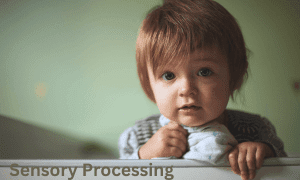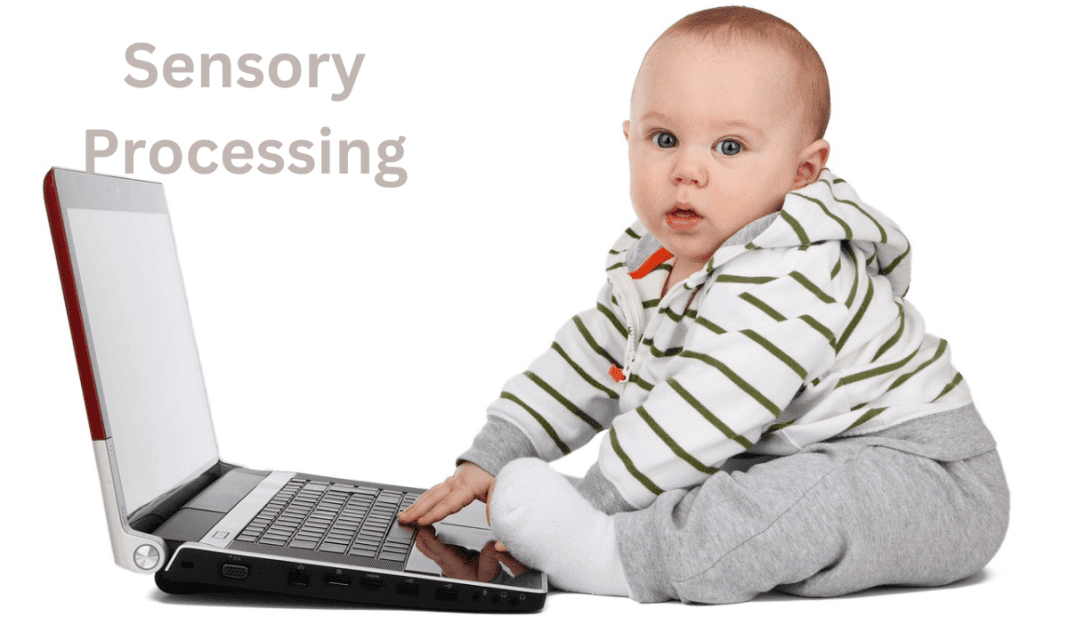Risks to Children’s “Sensory Processing” From Excessive Screen Time

What the body does as it receives and processes information from our senses is called sensory processing. The sensory system is An integral part of interacting with the environment.
To make good use of one’s body and environment, sensory processing sorts and differentiates between sensations experienced by one’s body and those experienced by one’s surroundings.
Sensory Processing
Our senses allow us to access the world around us. What the body does as it receives and processes information from our senses is called sensory processing.
The sensory system is an integral part of interacting with the environment. Our senses work together to tell our brain how to respond to and engage with the world around us.
This procedure allows us to track our location, degree of awareness in various environments, and mobility.
Even adults and teenagers often have trouble understanding what their senses are trying to tell them. Most people know their five senses: hearing, sight, touch, taste, and smell.
Not only that, but our three lesser-known senses also significantly impact our bodily interactions with the environment.
- Proprioception refers to our knowledge of our physical position;
- Vestibular is concerned with our ability to move, balance, and coordinate;
- and Interoception is our means of seeing and making sense of our internal bodily processes.
Why Family Meeting Agenda is Essential For A Successful Meeting
1, Why is it Crucial to Process and Integrate Sensory Information?


Because newborns’ sensory organs are still developing, the information gleaned from their eyes, ears, and bodies is useless. They have no concept of relative sizes or shapes and cannot distinguish between objects.
- Exposure to different sensory inputs develops a child’s ability to make sense of the world. Their performance increases because they learn to concentrate better on a single feeling.
- Their once clunky and jerky movement becomes more sophisticated, and they gain the ability to process more sensory information simultaneously. When they learn to organize feelings to modify their reactions, the youngster appear more attuned to their environment and in command of their emotions.
- When they can process information efficiently, children exhibit appropriate behaviour, attention, skill mastery, and self-regulation (managing their physical activity, emotional responses, and cognitive responses).
- This allows them to respond appropriately to their surroundings. The school allows children to sit still and focus on the most crucial parts of the curriculum, increasing the likelihood that they will reach their full academic potential.
In addition, the youngster can comprehend how their physique moves in connection to herself and their environment. With this, you may accomplish tasks using the entire body (gross motor skills). As a result, the child’s social development benefits.
2, How Can One Establish a Solid Foundation for Integrating Sensory Data and Motor Control?
All sensory systems need to collaborate when processing sensory information. It is critical to recognize that the sensory system consists of the seven senses, which absorb information and serve as the foundation for many other abilities.
- Visual sense: Good visual perception means you can understand what you see. The visual system gathers colour, motion, and light/dark contrast data through the eyes. It takes information about its surroundings visually using light waves to stimulate the retina.
- Auditory Sense: A person’s auditory sense is their capacity to understand and make sense of sounds they hear. The auditory system receives Noise and sound information through the outer and middle ear. They get data on loudness, pitch, and tempo. It is crucial to reduce sound to syllables and words.
- Gustatory Sense: The ability to understand what one tastes is known as gustatory sense. It identifies the chemical composition of a taste experience via the tongue and utilizes that information to decide whether the feeling is safe.
- Olfactory Sense: The capacity to detect and understand odours is known as olfactory sense. To ascertain whether an odour is dangerous, the nose gathers data on the chemical composition of airborne particles.
- Proprioceptive Sense: A person’s tactile sense is their capacity to make sense of data transmitted to the body through the skin. Skin receptors detect changes in temperature, vibration, pressure, and pain. The sense of touch is of utmost importance in the nervous system’s organization, as it is the initial sense to develop during gestation.
- Tactile sense: The capacity to perceive the relative positions of one’s bodily parts is known as proprioception. As the body moves, its muscles contract, stretch, bend, straighten, pull, and compress, relaying this information to the central nervous system via the corresponding nerves and skeletal sheaths.
- Vestibular sense: Good vestibular sense means you can decipher signals related to balance and movement. When you move your head, shift directions, or feel the pull of gravity, your vestibular system alerts you through the semicircular canals in your inner ear. It collects data on speed, balance, torso, eye, and neck movement, location, and space orientation.
3, What are the Symptoms of Sensory Processing/Integration Impairments in Children?


If a youngster is experiencing challenges with sensory processing,
- they may Pay little attention
- Act in an unacceptable manner
- Excessive movement or
- Being extremely sluggish and unmotivated, Slowly picking up and keeping new talents
- Lack the self-assurance to handle large groups of people
- Present a lack of maturity in their social skills
- Feel overwhelmed with worry
4, What are the Signs That My Kid May Be Having Difficulty Processing or Integrating Sensory Information?
A youngster who is having trouble processing sensory information may:
- Display heightened sensitivity to stimuli such as sound, touch, or motion.
- Have a high pain threshold, be inattentive to physical touch, or not react to the sound of their name.
- They look listless and uninterested and seem completely absorbed in their thoughts.
- They lack self-control in their actions and reactions, exhibit heightened emotional reactivity, act impulsively, and are quickly irritated or excessively submissive.
- Need help with focusing and paying attention.
- They lack developed motor planning, coordination, and balance abilities, exhibit clumsiness, and/or have trouble writing.
- Need more rest.
- Show signs of being a fussy eater or having limited eating habits.
- Feel anxious when doing things for oneself, such as cleaning one’s hair, cutting one’s nails, putting on one’s clothes, tying one’s shoes, or feeding oneself.
- Passionate about motion; seeks out stressful situations (such as being spun about constantly, racing around, jumping, or slamming into things or people).
- Avoid anything that needs movement, including slides, swings, etc.
- Seem slouched or weak, fatigue easily, and lack core strength in their postures.
- Works too quickly, uses excessive power, makes large motions, and writes either too light or too hard.
- Experience difficulties with social engagement and delayed communication.
- Does not know how to play with other kids or prefers to play alone.
- Struggle to adapt to new situations or shift gears between activities.
- Struggle to form and maintain friendships with classmates.
Childhood Emotional Neglect Can Lead to Four Major Problems in Adulthood
5, Problems With Sensory Processing and Motor Integration May Manifest in a Variety of Ways, Including:
- Maintaining focus and effort throughout an activity (i.e., not becoming sidetracked) is an important skill.
- Behaviour: What a person does, typically in connection to their surroundings.
- Body awareness is being familiar with anatomy and tracking one’s motion in space, including limbs.
- The ability to coordinate one’s motions so that they flow together smoothly is known as coordination.
- When people express themselves verbally, nonverbally, or via other means of communication, they can share their desires, needs, thoughts, and ideas with others.
- The ability to play is the willingness to engage in activities for enjoyment, regardless of whether such activities have a specific objective.
- Reading, writing, speaking, and listening are all forms of receptive language.
- Self-regulation is the capacity to obtain, maintain, and adjust one’s socially acceptable levels of emotion, behaviour, attention, and activity in response to certain tasks or situations.
- Speech sounds and linguistic clarity are referred to as articulation.
6, How Can One Better Integrate Their Senses With Their Motor Abilities?


Instruction in the several methods of management.
- Identifying the precipitating factors: Inform the child’s caretakers (parents, teachers, etc.) of what sets off the child’s abnormal sensory reactions and how to cope with them.
- External variables: Raise awareness among caregivers and parents about ways to lessen the impact of sensory-related environmental elements.
- A program designed to help individuals effectively regulate their emotions and behaviours using sensory and cognitive techniques.
- The M.O.R.E. program is a sensory control tool that combines motor components with oral organization, respiratory needs, and eye contact.
- One therapeutic approach is the Wilbarger Protocol, the Deep Pressure Proprioceptive Technique, or the Brushing program. Its goal is to help with sensory modulation and decrease tactile defensiveness.
Emotionally Secure Parents: Why IT Matter In Parenting
7, What Kinds of Things Can One Do to Enhance Their Sensory Processing and Motor Integration Abilities?
A sensory diet is a program that incorporates various sensory activities into a person’s daily routine to help the body better regulate its sensory input. Among these pursuits might be something like:
- Physically demanding mazes
- Walking with a wheelbarrow
- Pet romps
- Jumping on trampolines
- Rhythmic exercise
- Moves in a rotating, forward, and backward motion.
- Using balls or pillows as a squishy sandwich or engaging in rough-and-tumble play
- Walking about with a hefty rucksack on your back
- Things with a lot of weight, like a hefty blanket to sleep under or a wheat bag to sit on.
- Squeaky toys
- Children find seeing the next step in a process much easier when they can access visual timetables. People with a schedule are also more likely to be organized and prepare ahead.
- Visual timers help with transitions by showing the youngster how long an activity needs to be completed. We can also use timers to alert the youngster before a fun activity is about to stop.
Tips for Enhancing Your Performance, Mental Health and Wellbeing
8, Why is it Important to Seek Therapy if I am Experiencing Challenges With Motor Integration and Sensory Processing?
Helping a youngster who is having trouble processing sensory information requires therapeutic intervention to:
- Make sure the youngster can participate in educational activities.
- Let the kid learn to play, engage with others, and behave appropriately.
- Give the kids the space they need to handle hectic situations.
- If they need help following directions in the classroom or completing assignments, it could be challenging for them to adjust to school.
- The reason is that kids with sensory processing disorders don’t just “grow out of it;” they evolve and adapt to their environment, sometimes with more success than others.
9, What Are the Potential Consequences of Ignoring Sensory Processing Issues?


As a result of their issues with sensory processing, children may also struggle with:
- The child’s actions may reflect this, as they may lack the self-control to focus for long periods.
- Participating in preschool or elementary school programs despite difficulties with sustained attention required to learn the material by doing or to show proficiency on tests.
- Because of their lack of body awareness, they may injure their classmates or have problems learning to play cooperatively with others. These factors make it difficult for them to integrate socially.
- Disruptions to skill development caused by lack of sleep.
- Consistent behaviours that are hard to alter reduce stress.
When Kids Have Chronic Stomach Pain, What Usually Triggers It?
Risks to Children’s “Sensory Processing” from Excessive Screen Time
According to a recent study, there may be an increased risk of “sensory processing” impairment in infants and toddlers exposed to television and other digital media.
- Children characterized by “atypical sensory processing” tend to be more sensitive to environmental cues that are auditory, gustatory, or visual in nature.
- Some things that children may resist include the texture of some garments, the flavour of particular meals, or even washing their hair, which is an essential but unpleasant task.
- Conversely, they may ignore everything else in pursuit of sensations, such as spinning about aimlessly or fixating on ceiling fans or bright lights.
- Other mental disorders, including autism or attention-deficit hyperactivity disorder (A.D.H.D.), are strongly associated with sensory processing difficulties.
- According to studies conducted at Drexel University in West Reading, Pennsylvania, around 70% of autistic children and 60% of A.D.H.D. children struggle with sensory processing.
- From 2011 until 2023, they monitored roughly 1,500 youngsters. The study found that abnormal sensory processing symptoms were more common in children whose parents had exposed them to televisions and DVDs within the first three years of their lives, as opposed to children whose parents had deferred such exposures.
- Cause and effect could not be shown in the research. According to the Drexel group, kids’ screen usage might lead to less “meaningful play and social interactions,” which could affect how their senses develop and how well they handle day-to-day tasks.
- Dr. Karen Heffler, an associate professor of psychiatry at Drexel University, oversaw the research published in J.A.M.A. Pediatrics on January 8th.
- Children with abnormal sensory processing may have significant difficulties in daily life and reaching their full developmental potential.
- According to Heffler’s research, “Those with sensory sensitivity and sensation avoidance may be so overwhelmed by the environment that they have greater difficulty learning from the people around them.”
- The difficulties a child has processing sensory information might affect their caregivers since it causes problems “with family members’ participation in work, family and leisure activities,” as the researchers put it.
1, Does Excessive Screen Usage Throughout Childhood Lead to Abnormal Sensory Processing?


The Drexel group reached its conclusions by examining birth records from 1,471 children who participated in the United States National Children’s Study from 2011 to 2014. Participants’ parents were surveyed three times, at 12 months, 18 months, and 24 months, to gauge their children’s exposure to digital media.
Media consumption in this research was restricted to viewing television and DVDs. The researchers are hopeful, nevertheless, that their results could apply to other kinds of digital media.
About 11% of parents said their 18-month-old did not watch television or DVDs. In comparison, 48% said that their kid watched approximately one hour of such media daily, and 18% said that their child watched two hours. Slightly more than 8% indicated that their child watched three to five hours daily.
At 33 months of age, the children were tested for sensory processing using a conventional parent questionnaire.
According to Heffler’s research, children who began watching television or videos at 12 months of age were twice as likely to develop problems with “low registration” (inadequate response to environmental stimuli) as children who did not begin watching television or videos at such an early age.
Low registration and sensation avoidance behaviours were more common in children with increasing screen exposure at 18 months.
The research demonstrated that at 24 months, a higher likelihood of sensation-seeking, sensory sensitivity, and sensation-avoiding was associated with increased screen usage.
2, What’s Happening?
Evidence that children with abnormal sensory processing disorders and those who spend a lot of time in front of screens have neurological alterations was shown by Heffler’s group in their review of the literature.
The new results have the researchers questioning whether or not early exposure to digital media can contribute to the brain abnormalities seen in autistic children.
“To the extent that high screen time may increase the risk for A.S.D. [autism] symptoms, the current findings raise the possibility that screen time may do so by impacting sensory development,” Heffler’s team concluded.
Regardless, the results did have one positive aspect: parents can limit their children’s screen usage. According to Drexel University professor of psychiatry and lead research author David Bennett, “Parent training and education are key to minimizing, or hopefully even avoiding, screen time in children younger than 2 years,” a university news release stated.
In their study, Heffler and colleagues emphasized the need for parents to follow the advice of the American Academy of Pediatrics and keep their children off screens for at least 18 to 24 months.
What kind of therapy would you suggest if someone has trouble with sensory processing or motor integration?
You should take your child to an occupational therapist if they have trouble with motor integration or sensory processing.
Click on the provided link to receive notifications whenever a new article is published. If you found the post informative, please show appreciation by giving it some claps, likes, and shares with your contacts. Thank you! Additionally, you may follow us on Linkedin, Medium, or Twitter to receive a daily inspiring and meaningful quote.




